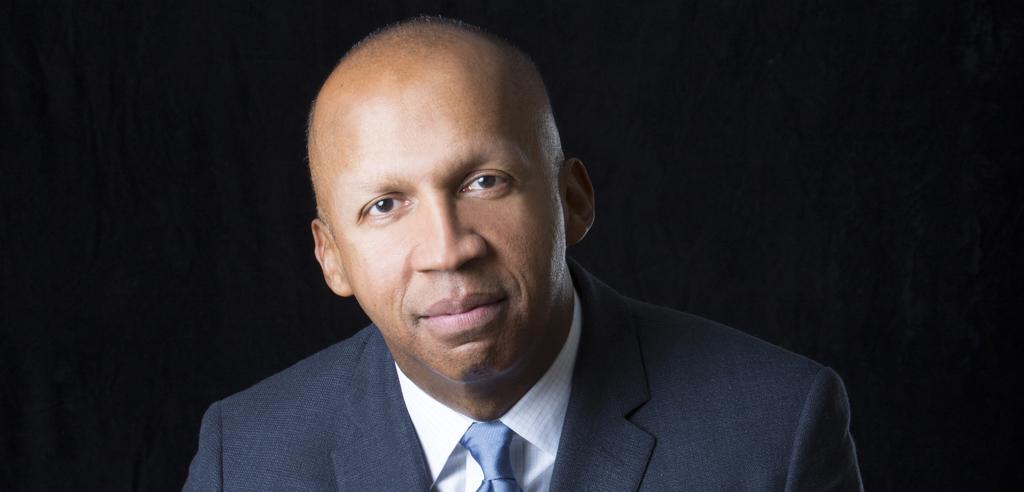In honor of Black History Month, we’ll be sharing staff reflections, artist highlights, and more here on our blog. The museum is also hosting programs, gallery conversations, and film screenings through the month of February. With these offerings, we’re aligning with the museum’s commitment of inclusion and expanding the understanding of American history through the lens of the Black experience.
In today’s blog, Associate Museum Educator Kentrell Curry reflects on the recent lecture by Bryan Stevenson as part of our Distinguished Speaker Series.

Associate Museum Educator Kentrell Curry
In December of 2018, Bryan Stevenson, the founder and Executive Director of the Equal Justice Initiative came to speak at the museum. For me, it was one of the most powerful talks I’ve ever heard. He spoke about a number of things that he felt were necessary in order to combat injustice in America. Through anecdotes, he connected our own human emotions to the experiences of the poor and disenfranchised. He spoke about getting proximate to those suffering and changing the narrative that has contributed to justifying mistreatment.
For me, changing the narrative was the biggest point. As an employee at an American art museum and someone who believes wholeheartedly in the power of art and media, I think that changing the narrative has to be one of our main focuses. The narrative of Blackness in America has seemingly changed over time but the underlying stereotypes associated with Blackness have not. The stereotypical assessment of Blackness dates back to the time of indentured servitude and one particular case where two white men and a black man, John Punch, attempt to escape servitude by running away. When they are caught, the two white men, James Gregory and Victor (last name unknown), receive a few extra years on their sentence while John Punch is ordered to “serve his said master or his assigns for the time of his natural Life.” This, in effect, made John Punch the first slave and set a course for the discrimination, humiliation, and mutilation of Black people that have been prevalent throughout American history.
Throughout American history, Black people have been labeled as inferior, savage, angry, thugs, super-predators, and so much more. These labels have contributed to a narrative of Blackness that has justified lynching, over-policing in Black neighborhoods, and most recently, the murder of black bodies at the hands of the police.
Since this talk, I have been reflecting on the narrative of Blackness in America and what it will take to change that, and I think we have to be ready to get uncomfortable in order to impact this false narrative. Being uncomfortable means bringing powerful speakers like Patrisse Cullors and Bryan Stevenson into white spaces like museums. It means having Black people in positions to contribute their point of view to initiatives. It also means giving Black people the power and space to create art. Art is one of the most powerful contributions to the narrative, and Black people have used it throughout history to help combat the false narratives that exist. Exhibitions like Soul of a Nation: Art in the Age of Black Power, films like 12 Years a Slave and BlacKkKlansman, and memorials like the Legacy Museum are essential to helping change the narrative. On the other side of the spectrum, we need non-POCs to be bold.

Soul of a Nation: Art in the Age of Black Power while it was on view at Crystal Bridges, February 3 – April 23, 2018.
While Stevenson did talk a lot about the experiences of Black folks, he also mentioned the importance of having allies to help combat injustice. We first need people to get closer to the spaces where injustices are happening, getting closer the people in those spaces to learn what their needs are. From there, we need those people to go into the spaces they’re familiar with and challenge the misconceptions about people of color that might manifest in those spaces. If you truly want to make an impact, you cannot be afraid to challenge these narratives, and you must do your part by being vocal and taking action against injustice.
Stevenson’s talk is something that I wish everyone could have heard because it was that powerful. For those who want to work towards changing the narrative, I’ll leave you with these four points:
- Get proximate to the people who are impacted by injustice.
- Do all you can to change the racist narratives that plague our society.
- Do things that make you uncomfortable because they are for the greater good.
- Remain hopeful.
If we can all take these four points and apply them in our own lives, I think we are headed in the right direction. If we can go into spaces of comfort and challenge the status quo then we are headed in the right direction. If we are willing to be vulnerable and work towards equity, then we are headed in the right direction. I hope that you will take a moment to see where you can apply these things in your life and help us propel our society towards justice.
Blog written by Associate Museum Educator Kentrell Curry.




